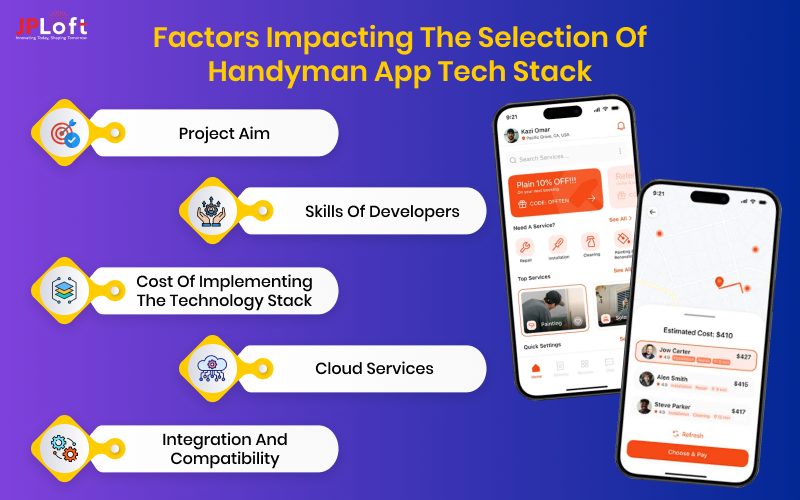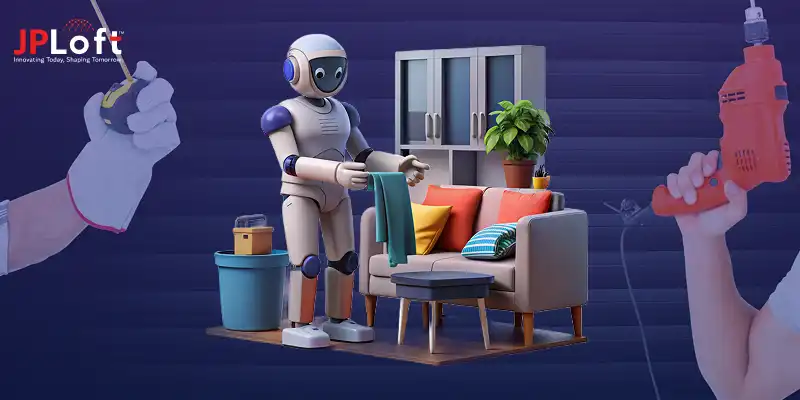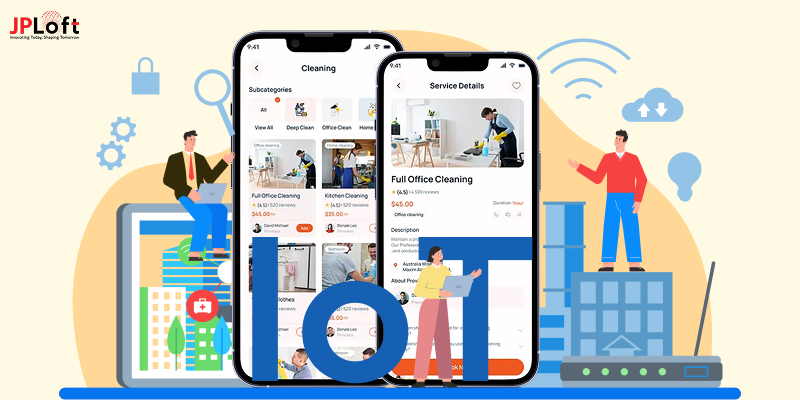Confused about selecting an ideal handyman app tech stack?
The technology stack is the set of tools, programming languages, and technologies that work together to create digital solutions such as websites, mobile apps, and web apps.
Well, want to know more about how to add a tech stack in the handyman app?
Let’s find it all out here.
Along with the tech stack, you should know the concept, evaluate the factors impacting the same, and identify the steps to select the same.
Are you ready to begin?
About Handyman App Tech Stack
Let’s learn more about the handyman app and its related stats first.
The handyman apps are mobile apps that connect homeowners with local, skilled service providers for various home repair and improvement tasks.
When it comes to the tech stack for handyman apps, finding a service provider, booking and scheduling, securing payment, and more.
The handyman app tech stack is all about building the technologies that will help support the built-in features of the app.
Let’s evaluate the current Handyman market stats below.
-
In the year 2025, the global handyman service market is poised for robust growth through 2035, which is driven by increasing urbanization, rising demand for home improvement, and other service associations.
-
The global handyman service market was around USD 421.4 million in the year 2023. It is estimated to grow to around USD 1,197.10 million by 2032 with a compound annual growth rate (CAGR) of roughly 12.30% between 2024 and 2032.
-
Additionally, this market size is worth USD 1,579.14 million by the year 2033 at a 16.5% CAGR.
Let’s learn more about the same through learning about the basics and components to include in the tech stack for your handyman app in the following sections.
Basics of App Tech Stack
Want to develop a handyman app?
You cannot proceed without evaluating the technology stack.
Before you switch to the components to include in the tech stack, let’s evaluate the basics of the same here.

This section provides you with in-depth details of the same.
1. Frontend App Tech Stack
It is the foremost component when it comes to a handyman app tech stack. This comprises the user interface of an app, built with languages like CSS, HTML, JavaScript, and frameworks like React, Angular, or Vue.js.
2. Backend App Tech Stack
The backend app tech stack comprises tools and technologies used to create the server-side of a software application. It includes languages like PHP, Java, Ruby, and Python. The technical app tech stack is all about selecting the type of technologies supporting the app.
3. Development Tools
These are the tools used for building, testing, and deploying the app. Such tools are IDEs, version control systems, such as Git, along with testing tools, including JUnit and Espresso. The high-tech stack is all about identifying the programming languages, frameworks, and related tools.
4. Database Management System
The database management system is a software application that helps to create, manage, and interact with the database. This is an important technology stack that provides a structured way to organize, retrieve data, enabling the efficient data handling for the handyman app tech stack.
5. Servers
Servers are the physical and virtual machines that help to run the backend logic and handle requests from clients such as web browsers and mobile apps. This is the backbone of the tech stack and is responsible for handling requests and processing data simply.
6. Firewall and Security Measures
Through the firewall and security measures, you can protect the server and data from unauthorized access and threats. It is a critical network security component that acts as a barrier for monitoring and controlling traffic between a trusted internal and external network.
These were the basics that you can consider for the mobile app tech stack.
Now, let's consider the components to include in the Handyman app tech stack in the proceeding section.
What are the components to include in the Handyman App Tech Stack?
It's important to evaluate the number of components to include in the tech stack for a handyman app when you head into the industry.

Let’s learn more about the components below.
► UI/UX of Handyman apps
The foremost technology stack selection lies in the app design. It is a clear dashboard highlighting available services and categories, making it simple for users to find what they need.
When it comes to handyman app design, the selection should be simplified and authentic. The UI/UX of the app can comprise technologies such as web design, CSS, HTML, and JavaScript.
The components should be clean with minimalist design, accessible language, and responsive design. The design must be user-friendly, consistent, accessible, and highly interactive. This comprises a clear and intuitive interface for booking services, scheduling, and tracking progress.
► Programming Languages
The programming language is a set of instructions that a computer can understand and execute to perform specific tasks. Additionally, it provides a structured way for programmers to communicate with the computers.
The programming languages that can be included within the handyman app tech stack can be JavaScript, Java, SQL, Kotlin, Python, Objective-C, React Native, Flutter, Angular, and Linux.
The selection of the programming languages completely depends on the project's aim, its required features, and the developers' skill sets.
► Databases
Databases are an essential component of the handyman tech stack. In this process, you can include databases such as MySQL and MongoDB. These databases help to keep everything organized and accessible.
These databases come in various forms, from simple spreadsheets to complex relational systems, and are used for a wide range of activities. For a handyman app, you can use relational databases such as PostgreSQL or MySQL.
Additionally, you can implement NoSQL databases such as MongoDB, Couchbase. For the hybrid approaches, you can use a combination of different types of databases.
► Third-Party APIs Integration
There are various payment gateways that your app can include, like Stripe or PayPal, that ensure that the users can make secure payments through the app.
These APIs are essential for integrating functionality and data within the handyman apps, enabling features like payment processing, location tracking, and communication within the apps.
Furthermore, you can include the APIs, such as location and mapping services, payment gateways, customer support, and social media integration. This is also among the handyman app trends that are impacting the overall development process.
► Operating System
The operating services can be defined as the backend infrastructure and services that keep the apps running. When it comes to the tech stack of handyman apps, you can include the operating services that may comprise cloud hosting platforms.
Further, the cloud hosting platforms that you can implement are Amazon Web Services (AWS), Google Cloud Platform (GCP), Microsoft Azure, DigitalOcean, and Local Indian Cloud Providers.
The selection of an operating system depends on factors such as the processor architecture, hardware peripherals, real-time processing, and resource requirements.
► Security Feature
The mobile app technologies that can be included in the Handyman app tech stack are secure authentication, which should include strong password policies, enforce minimum length and complexity requirements, along with regular password updates.
You can further include data encryption, such as HTTPS, end-to-end encryption, and encryption of local data. It minimizes the data exposure, as well as stores the necessary user data, and avoids including sensitive information.
It helps in securing data handling, including input validation, data sanitization, and minimizing data exposure.
You can check out the table below to identify the core technologies to implement in the handyman app in brief.
|
Category |
Key Technologies/Services |
Notes |
|
Mobile (User/Handyman) |
React Native / Flutter / Native (Android/iOS), Maps (Google/MapmyIndia), Payment (Razorpay/Paytm), FCM |
Choose a framework based on speed/performance. MapmyIndia for local accuracy. |
|
Backend & APIs |
Node.js/Python/Java/PHP, JWT, API Gateway (AWS/GCP/Kong) |
Select based on team skill & scalability needs. Secure authentication is crucial. |
|
Database |
PostgreSQL / MySQL (+ optional MongoDB for flexible data) |
Reliable data storage. Consider NoSQL for specific needs like reviews. |
|
Operating Services |
AWS / GCP / Azure / DigitalOcean (+ local options), Redis |
Cloud hosting for scalability & reliability. Redis for caching to improve speed. |
|
Security |
HTTPS, Security Libraries, WAF (AWS/Cloudflare) |
Essential for data protection and preventing attacks. |
|
Other Services |
SMS (MSG91/Twilio), Push (FCM), Analytics (Firebase/Mixpanel) |
Local SMS providers for better delivery. Analytics for user insights. |
This is the critical technology stack for handyman apps that you can include in your handyman app. Well, there are certain essential factors impacting the selection of a handyman app tech stack.
Let’s learn them all in the next section.
Factors Impacting the Selection of Handyman App Tech Stack
What are the key factors impacting the overall selection of the technology stack?

Here is the list that should be noted.
A] Project Aim
The objectives of your handyman app project have an impact on the selection of the technology stack. A clear understanding of the project will help you to measure complexity, and assist in determining the best tools for creating the backend of the app.
Your Handyman app should ensure efficiency and alignment with the business objectives. Additionally, you can analyse the data and may examine the project requirements before technology selection.
B] Skills of Developers
The type of developers you hire for your app has a high impact on your selection process for an ideal handyman app tech stack. You should evaluate the skills of the developers before hiring them in this competitive market.
For selecting the top technologies, it's essential to consider the viability and practicality of the app for different technologies for a project. So, hiring mobile app developers with specialized skills can help you identify the potential and an ideal tech stack.
C] Cost of Implementing the Technology Stack
Along with this, the cost has a high impact on selecting an ideal tech stack for the handyman app. It will impact your choice of tech stack. A highly complex technology will have a large impact on your app.
Additionally, the organization considers various factors that comprise upfront costs, ongoing maintenance, and the potential for long-term savings. Well, the complete cost to create a handyman app will depend on the types of technologies you select for your project.
D] Cloud Services
The cloud services do impact the selection of an ideal tech stack of handyman apps by enabling efficient project management, streamlining communication, as well as broadening the platform compatibility.
Additionally, the cloud services are one of the important aspects by enabling the platform compatibility and streamlining document management.
E] Integration and Compatibility
Integration and compatibility impact the tech stack by impacting the functionality, efficiency, and scalability of an app. Poor integration can lead to disjointed systems, manual processes, and duplicated efforts, hindering overall efficiency.
Compatibility issues, such as those between different versions or platforms, can result in development delays and limited scalability.
These were the factors that impacted the complete selection of the tech stack for handyman apps.
Now, as we have covered all the essentials of the tech stack, it's time to know the process.
Are you ready to proceed?
How to Select an Ideal App Tech Stack for Your Handyman App?
Learning about the components of an ideal handyman tech stack isn’t sufficient.
Well, how do you think that the top handyman apps are able to process with an ideal tech stack?
Yes, implementing the crucial process is the ultimate solution. You should go with the important steps as stated below to select an ideal tech stack for a handyman app.

Let’s learn it all here.
Step 1: Market Research
Nothing should be pursued without efficient research. Here, you should understand the audience, need to explore the market gaps, and evaluate the market offerings. This research will help you understand the prospective trend in the handyman market.
Additionally, it's important to conduct competitor analysis at this stage. You should choose appropriate research methods, including surveys, interviews, and focus groups, accordingly.
Step 2: Connect with Skilled Developers
You should proceed to connect with the skilled developers who need to be wise enough to select an ideal tech stack for your app.
Here, you should evaluate the location and skills of the developers and then require them to discuss with you your objectives and feature selection.
Step 3: Evaluate the Prospective Technologies
Now, it's time to evaluate the prospective technologies that can enable your app to support all the selected handyman app features.
Now, you should evaluate the prospective technologies to include for your handyman apps after consulting with the prospective developers.
Step 4: Implement and Test
Well, it's the right time to implement the technologies for your handyman app. You can create the app prototype and then test it simultaneously.
It's significant to select the tech stack that can directly influence development speed, application performance, cost, scalability, and the ability to attract technical talent.
Step 5: Document Your Decision
Now, it's time to document the overall decision that should clearly include why you chose technology in the tech stack.
Documenting your decision will be invaluable for onboarding the new team members, and that too for future references.
These were some of the steps that you should consider white developing an ideal tech stack for your dream handyman app.
Connect JPLoft and Implement an Ideal Tech Stack for Your App
Still confused about how to proceed with the handyman app tech stack?
Connecting with the best Handyman App Development Company can help you. Our team can help you with conducting an in-depth market analysis that will assist you in identifying the target audiences and how you can approach them.
With JPLoft, you can convert your dream app into a success easily. Our team is ready to help you with the latest trends and how to include them in your app.
We have already done it before. Check out our work here.
Fixit is an app developed by our team that connects homeowners with tradespeople for home maintenance tasks. This app allows users to find and compare profiles of electricians, carpenters, plumbers, and other tradespeople. Here, the users can find professionals who can help them with repairs and maintenance, and various other on-demand services.
Are you ready to connect?
Conclusion
Overall, selecting the right tech stack is crucial for developing a successful handyman app. This involves careful consideration of factors like project goals, developer skills, costs, and integration needs.
The ideal stack should encompass a user-friendly UI/UX (built with technologies like HTML, CSS, and JavaScript), robust programming languages (such as Java, Kotlin, or React Native), efficient databases (like MySQL or MongoDB), and secure operating services (such as AWS or Azure).
By following a structured approach that includes market research, expert consultation, and thorough testing, businesses can implement a tech stack that meets their specific requirements and ensures a high-performing, scalable, and secure handyman application.
FAQs
The tech stack for a handyman app refers to the collection of technologies used to build the app's features, including finding service providers, booking services, scheduling, and processing payments. It encompasses frontend and backend development tools, programming languages, databases, servers, and security measures.
The key components include:
- Frontend (UI/UX)
- Backend
- Programming languages
- Databases
- Third-party APIs
- Operating systems
- Security features
Factors to consider include:
- Project aim
- Skills of developers
- Cost of implementation
- Cloud services
- Integration and compatibility
Some programming languages that can be used are JavaScript, Java, SQL, Kotlin, Python, Objective-C, React Native, Flutter, Angular, and Linux.
Commonly used databases include MySQL and MongoDB. The choice depends on whether you need a relational or non-relational database structure.













Share this blog